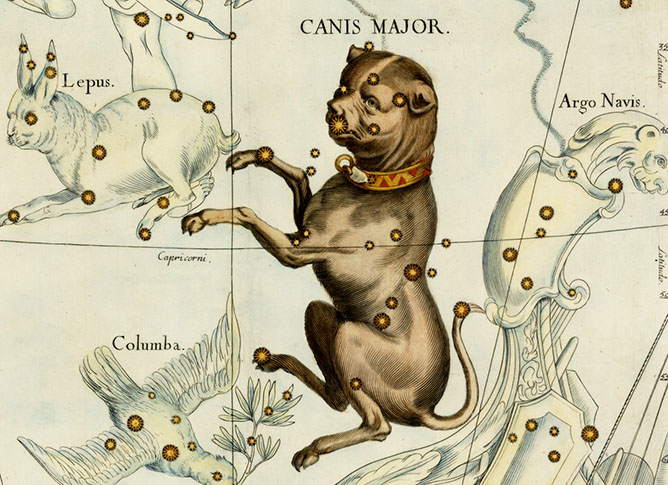Canis Major: The Great Dog
Pronunciation: CANE-iss (CAN-iss) MAY-jer Canis Major as depicted by Johannes Hevelius in his Firmamentum Sobiescianum sive Uranographia (1687). Source image provided by www.RareMaps.com — Barry Lawrence Ruderman Antique Maps Inc.
Canis Major as depicted by Johannes Hevelius in his Firmamentum Sobiescianum sive Uranographia (1687). Source image provided by www.RareMaps.com — Barry Lawrence Ruderman Antique Maps Inc.
| Canis Major Constellation Profile | |
|---|---|
| Abbreviation: CMa | Genitive: Canis Majoris |
| Origin: Ancient | Location: Southern Hemisphere |
| Best View (North): Winter | Best View (South): |
| Bordering Constellations: Monoceros, Lepus, Columba, Puppis | |
The Myth Behind the Constellation Canis Major
There have been a number of mythical dogs tied to Canis Major. One is that Canis Major, “the great dog”, and Canis Minor, “the little dog”, are the hunting companions of Orion, “the hunter”. In another myth, Canis Major is Laelaps, a dog so swift that it was destined that no pray would outrun it. He was used to hunt down the Teumessian Fox, a beast so sly that it was destined to never be caught. On-and-on the chase went, the fox unable to outrun the dog and the dog unable to catch the fox. Finally, Zeus put an end to this paradox by turning them both to stone.Canis Major Constellation Points of Interest
| Interesting Objects in the Constellation Canis Major | ||||
|---|---|---|---|---|
| Name | Messier | NGC | Type | Visibility |
| M41 | NGC 2287 | Open Cluster | Naked-Eye | |
Bright Stars in Canis Major
These are the stars in Canis Major with a minimum magnitude of 3.0.| Name | Bayer Name | Magnitude | Color | Luminosity | Distance |
|---|---|---|---|---|---|
| Sirius | Alpha Canis Majoris | -1.42 | White | 27 suns | 8.6 ly |
| Adhara | Epsilon Canis Majoris | 1.50 | Blue | 18,079 suns | 431 ly |
| Wezen | Delta Canis Majoris | 1.83 | Yellow-White | 53,819 suns | 1791 ly |
| Mirzam | Beta Canis Majoris | 1.98 | Blue-White | 22,844 suns | 499 ly |
| Aludra | Eta Canis Majoris | 2.45 | Blue | 139,337 suns | 3196 ly |